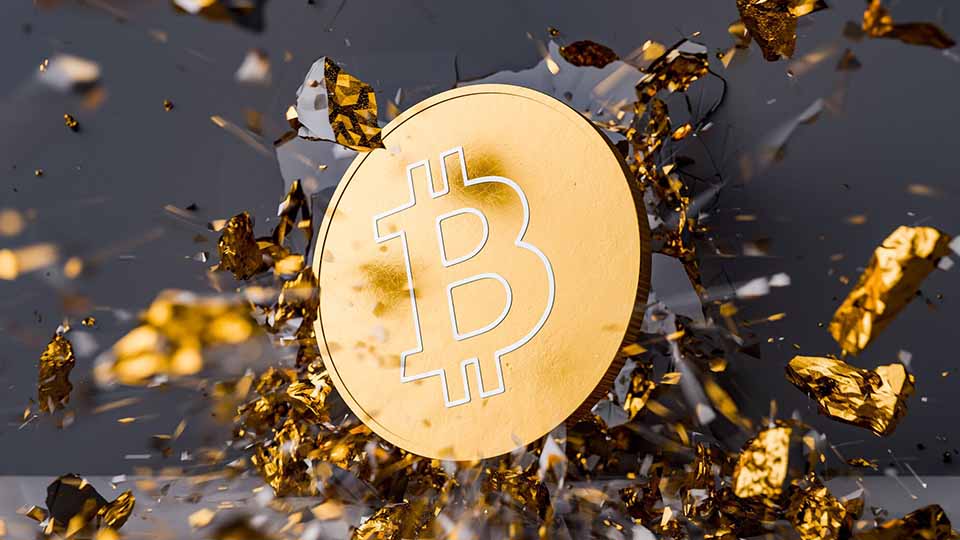The Investment Case for Bitcoin
30 May 2024
Read Time 8 MIN
Please note that VanEck has exposure to bitcoin.
We often refer to bitcoin as “digital gold” because, like the metal, it is a potential store of value. Like gold, bitcoin’s characteristics include:
- Limited supply: Maximum supply of 21 million. This scarcity means that the price could move upward as adoption increases.
- Increasing adoption: Bitcoin has been gaining traction in terms of the number of merchants that accept it as payment. In 2021, El Salvador made headlines by declaring Bitcoin as legal tender. As the first country to do so, El Salvador serves as a good macro case study for bitcoin as legal tender.
- Potential inflation hedge: Monetary stimulus is currently eroding purchasing power globally and bitcoin might outperform as it’s not subject to the same inflationary manipulation as traditional currencies.
- Diversification benefits: Bitcoin is an uncorrelated asset.
However, unlike gold, bitcoin is:
- Divisible and transparent.
Bitcoin’s Limited Supply Creates Scarcity and May Increase Its Value Over Time
There will only ever be 21 million bitcoin in existence. This supply cap was designed intentionally and is one of the primary characteristics of bitcoin. Furthermore, bitcoin has “halvings” programmed into it. A halving is defined as a 50% block reward cut to the bitcoin production rate, and they occur roughly every four years. This means that the rate at which new bitcoins are introduced into circulation slows down over time until it eventually reaches zero (estimated to occur around the year 2140).
Bitcoin Halvings Typically Associated with Explosive Returns
Source: Bloomberg, VanEck research as of 31/03/24. Past performance is not indicative of future results. The information, valuation scenarios and price targets presented on Bitcoin in this blog are not intended as financial advice or any call to action, a recommendation to buy or sell Bitcoin, or as a projection of how Bitcoin will perform in the future. Actual future performance of Bitcoin is unknown, and may differ significantly from the hypothetical results depicted here. There may be risks or other factors not accounted for in the scenarios presented that may impede the performance of Bitcoin. These are solely the results of a simulation based on our research, and are for illustrative purposes only. Please conduct your own research and draw your own conclusions.
These halvings increase the difficulty of mining bitcoin and will occur until the supply cap is reached. In addition, the built-in finite supply of bitcoin means that it is not subject to inflation in the same manner that fiat currencies are. Central banks around the world have ushered in unprecedented growth in money supply, effectively eroding their currencies’ purchasing value. In comparison, bitcoin’s limited supply and increased mining difficulty over time may support the idea of bitcoin as a long-term store of value and as an alternative to gold.
The fourth halving occurred in April 2024. Historically, the price of bitcoin has rallied leading up to and following a halving. The chart above indicates the explosive returns that are typically associated with following the bitcoin halvings.
Bitcoin Adoption Continues
In its early years, bitcoin was largely used by a small group of tech enthusiasts. It was difficult and cumbersome to obtain with limited use cases and very few merchants accepting it as a form of payment. In 2023, bitcoin adoption has grown substantially as it has become more mainstream. Now, more than ever, merchants and businesses are accepting bitcoin as a form of payment and infrastructure has been built to make it more convenient for the average person to use. The development of user-friendly wallets, exchanges, and marketplaces has removed the technical barriers to entry that existed in bitcoin’s early years.
Bitcoin interest among institutional investors has also increased. Hedge funds, asset management firms, and endowments are increasingly recognizing bitcoin’s potential as a store of value and as an effective portfolio diversifier, specifically, when looking through the lens of an uncorrelated asset that has the potential to hedge against inflation. Approximately $175B worth of bitcoin are now held by ETFs, countries, public and private companies.
BTC Holdings in Publicly Traded, Private Companies, ETFs and Countries
Source: Buybitcoinworldwide as of 31/03/2024. Past performance is not a guarantee of future results.
Layer 2s (such as Liquid by BlockStream) may be the next step in boosting bitcoin adoption as they allow for scalability and customizations while retaining many of bitcoin’s security properties. Built on top of the Bitcoin blockchain, we believe the Lightning Network pushes the boundaries of Bitcoin payment capabilities with lower costs and faster speeds.
One notable upcoming layer 2 development on the bitcoin network is RGB. This development is important because it enables the creation and management of digital assets on top of the Bitcoin blockchain. Assets such as stocks, bonds, real estate, or even other cryptocurrencies can be issued and traded on top of the Bitcoin network, adding a new layer of functionality. The RGB protocol is designed to be scalable and not resource-intensive, allowing users to create and manage digital assets without requiring extensive changes to the underlying Bitcoin network. It can be integrated into existing bitcoin wallets and infrastructure, thus making it easier for developers and users to create and manage digital assets. RGB has the potential to expand the use cases of bitcoin, making it a more versatile and useful platform for developers and users alike, ushering in new opportunities for innovation and growth within the ecosystem.
Potential Hedge Against Inflation
The unprecedented worldwide growth in money supply following the COVID-19 pandemic led to widespread inflation, eroding the purchasing power of established fiat currencies. Bitcoin’s role as a potential hedge against inflation has increasingly become a talking point central to investment decision-making. As previously alluded to, the cornerstone of this idea lies in its limited supply and decentralized nature. Unlike fiat, which can be printed by governments and central banks, bitcoin has a fixed supply, with supply growth decreasing by 50% roughly every 4 years with the halving events. Bitcoin is not subject to the same inflationary pressures caused by fiat money supply growth, making it an attractive option for investors concerned about the impact of inflation on their portfolios and their subsequent purchasing power.
Bitcoin’s decentralized nature makes it impervious to geopolitical events or economic policies that may lead to currency devaluation, such as QE (quantitative easing) or excessive government spending.
The Role of Bitcoin
If bitcoin is increasingly used as an asset with monetary value, what role might it play?
Bitcoin may potentially increase portfolio diversification because of its low correlation to traditional asset classes.
Bitcoin Correlation with Nasdaq Has Fallen Considerably
Source: Bloomberg as of 31/03/2024. Past performance is not a guarantee of future results.
Bitcoin may also enhance risk-return profiles. As the chart below shows, a small allocation to Bitcoin significantly enhanced the cumulative return of a traditional 60% equity and 40% bond mix while only minimally impacting overall volatility.
Small Bitcoin Exposure Enhances Results
Source: Morningstar. Data as of 31/03/2024. Equities are represented by the S&P 500 Index, Bonds are represented by the Bloomberg Barclays US Aggregate Index, Bitcoin is represented by the MarketVector Bitcoin Index. Past performance is no guarantee of future results. Not intended as a recommendation to buy or sell any securities mentioned herein, to adopt any investment strategy, or as any call to action. Index performance is not representative of fund performance. It is not possible to invest directly in an index. Please see important disclosures at the end of this commentary regarding hypothetical performance.
| 1 year Return |
3 year Return |
5 year Return |
Since Inception Return (Annualized) |
Since Inception Std Dev |
Since Inception Max Drawdown |
Since Inception Sharpe Ratio |
|
| 60% Equities / 40% Bonds | 17.97 | 5.94 | 9.30 | 9.24 | 9.33 | -20.10 | 0.87 |
| 59.75% Equities / 39.75% Bonds / 0.5% Bitcoin | 18.50 | 6.04 | 9.69 | 9.95 | 9.47 | -20.30 | 0.92 |
| 59.5% Equities / 39.5% Bonds / 1% Bitcoin | 19.02 | 6.15 | 10.09 | 10.65 | 9.68 | -20.50 | 0.97 |
| 58.5% Equities / 38.5% Bonds / 3% Bitcoin | 21.15 | 6.56 | 11.66 | 13.45 | 11.08 | -21.31 | 1.09 |
Source: Morningstar. Data as of 31/03/2024. Past performance is no guarantee of future results. Not intended as a recommendation to buy or sell any securities mentioned herein, to adopt any investment strategy, or as any call to action. Index performance is not representative of fund performance. It is not possible to invest directly in an index. Please see important disclosures at the end of this commentary regarding hypothetical performance.
Bitcoin’s History of Robust Performance
Despite its infamous volatility, bitcoin has managed to outshine other asset classes over the past decade. In fact, it has been the best-performing asset class for eight out of the past eleven years.
Let's take a closer look at bitcoin's historical returns for various holding periods (as of 31 March 2024):
- 1 year: 147.89% return
- 3 years: 19.46% return
- 5 years: 1,598.56% return
- 7 years: 7,654.74% return
- 10 years: 18,719.44% return
These figures underscore the incredible growth potential that bitcoin has exhibited over time, making it an attractive option for investors seeking high returns.
Bitcoin Has Been the Best Performing Asset Class in 8 Out of the Past 11 Years
Source: Morningstar, as of 31 March 2024. Bitcoin is represented by MarketVector Bitcoin PR USD; US Equities are represented by the S&P 500 TR USD; Gold is represented by the S&P GSCI Gold Spot; Emerging Markets is represented by Fidelity Emerging Markets TR; Real Estate is represented by the NASDAQ Global Real Estate TR USD; US Bonds are represented by Bloomberg US Aggregate Bond USD; Treasuries are represented by the Bloomberg Aggregate Bond Treasury TR USD; Commodities are represented by the Bloomberg Commodity TR USD.
How Might Bitcoin Shine Brighter Than Gold?
While bitcoin shares some of the characteristics attributed to gold, below are differences that, in our view, potentially make it superior.
- Divisible: As a physical asset, gold can only be divided into smaller units to a certain extent, making smaller transactions cumbersome and, in some instances, impractical. Bitcoin, on the other hand, is divisible up to eight decimal places (with the smallest unit called Satoshis), making it easier to use for microtransactions.
- Transparency: All transactions that have ever occurred or will occur are publicly available on the Bitcoin blockchain. This feature makes it difficult to manipulate and impossible to counterfeit Bitcoin, increasing trust in the network. Gold lacks the same level of transparency – when it is traded, the details of the transaction, such as the buyer, seller, and price, are often not publicly available. This lack of transparency may make it more difficult to verify the authenticity of the gold being traded and may lead to an increased risk of fraud and manipulation.
Overall, while gold has been used as a store of value and in transactions for centuries all over the world, its lack of transparency can make it more challenging to verify and track compared to digital assets like bitcoin. As inflation poses challenges to investors globally, both gold and bitcoin are likely to come front and center as potential hedges to protect purchasing power. With bitcoin’s benefits like divisibility and transparency, we see it as a competitor to gold, and believe it is likely to garner even more adoption among retail and institutional investors alike.
To receive more Digital Assets insights, sign up to our Newsletter.
This is not financial research but the opinion of the author of the article. We publish this information to inform and educate about recent market developments and technological updates, not to give any recommendation for certain products or projects. The selection of articles should therefore not be understood as financial advice or recommendation for any specific product and/or digital asset. We may occasionally include analysis of past market, network performance expectations and/or on-chain performance. Historical performance is not indicative for future returns.
Important information
For informational and advertising purposes only.
This information originates from VanEck (Europe) GmbH, Kreuznacher Strasse 30, 60486 Frankfurt am Main. It is intended only to provide general and preliminary information to investors and shall not be construed as investment, legal or tax advice. VanEck (Europe) GmbH and its associated and affiliated companies (together “VanEck”) assume no liability with regards to any investment, divestment or retention decision taken by the investor on the basis of this information. Views and opinions expressed are current as of the date of this information and are subject to change with market conditions. Certain statements contained herein may constitute projections, forecasts and other forward looking statements, which do not reflect actual results. VanEck makes no representation or warranty, express or implied regarding the advisability of investing in securities or digital assets generally or in the product mentioned in this information (the “Product”) or the ability of the underlying Index to track the performance of the relevant digital assets market.
The underlying Index is the exclusive property of MV Index Solutions GmbH, which has contracted with CC Data Limited to maintain and calculate the Index. CC Data Limited uses its best efforts to ensure that the Index is calculated correctly. Irrespective of its obligations towards the MV Index Solutions GmbH, CC Data Limited has no obligation to point out errors in the Index to third parties.
Investing is subject to risk, including the possible loss of principal up to the entire invested amount and the extreme volatility that ETNs experience. You must read the prospectus and KID before investing, in order to fully understand the potential risks and rewards associated with the decision to invest in the Product. The approved Prospectus is available at www.vaneck.com. Please note that the approval of the prospectus should not be understood as an endorsement of the Products offered or admitted to trading on a regulated market.
Performance quoted represents past performance, which is no guarantee of future results and which may be lower or higher than current performance.
Current performance may be lower or higher than average annual returns shown. Performance shows 12 month performance to the most recent Quarter end for each of the last 5yrs where available. E.g. '1st year' shows the most recent of these 12-month periods and '2nd year' shows the previous 12 month period and so on. Performance data is displayed in Base Currency terms, with net income reinvested, net of fees. Brokerage or transaction fees will apply. Investment return and the principal value of an investment will fluctuate. Notes may be worth more or less than their original cost when redeemed.
Index returns are not ETN returns and do not reflect any management fees or brokerage expenses. An index’s performance is not illustrative of the ETN’s performance. Investors cannot invest directly in the Index. Indices are not securities in which investments can be made.
No part of this material may be reproduced in any form, or referred to in any other publication, without express written permission of VanEck.
© VanEck (Europe) GmbH
Important Disclosure
This is a marketing communication. Please refer to the prospectus of the UCITS and to the KID before making any final investment decisions.
This information originates from VanEck (Europe) GmbH, which has been appointed as distributor of VanEck products in Europe by the Management Company VanEck Asset Management B.V., incorporated under Dutch law and registered with the Dutch Authority for the Financial Markets (AFM). VanEck (Europe) GmbH with registered address at Kreuznacher Str. 30, 60486 Frankfurt, Germany, is a financial services provider regulated by the Federal Financial Supervisory Authority in Germany (BaFin).
The information is intended only to provide general and preliminary information to investors and shall not be construed as investment, legal or tax advice VanEck (Europe) GmbH, VanEck Switzerland AG, VanEck Securities UK Limited and their associated and affiliated companies (together “VanEck”) assume no liability with regards to any investment, divestment or retention decision taken by the investor on the basis of this information. The views and opinions expressed are those of the author(s) but not necessarily those of VanEck. Opinions are current as of the publication date and are subject to change with market conditions. Certain statements contained herein may constitute projections, forecasts and other forward-looking statements, which do not reflect actual results. Information provided by third party sources is believed to be reliable and have not been independently verified for accuracy or completeness and cannot be guaranteed. Brokerage or transaction fees may apply.
All performance information is based on historical data and does not predict future returns. Investing is subject to risk, including the possible loss of principal.
No part of this material may be reproduced in any form, or referred to in any other publication, without express written permission of VanEck.
© VanEck (Europe) GmbH / VanEck Asset Management B.V.
Sign-up for our ETF newsletter
Related Insights
Related Insights
14 March 2025
16 January 2025
27 November 2024
27 November 2024




